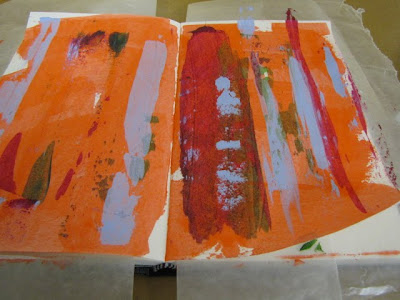
Well, I am hale and hearty. I visited with a homeopath about the headaches and am having some very wierd dreams on the Constitutional, as well as a bit of luck staving off the sad behavior that begets the headaches. (See the entry below for why in the world I am chatting about my head health.)
So, back on board, I was perusing last summer's issue of QA>>>>>
and came upon this great article/lesson about making what I am calling "crayon paper".
Oh! And I am so sorry: I cut off her name in the picture of the article and the mag is not with me at the moment.
She starts with paper - like bond I think, or drawing weight? I started with brown paper bag because, well, I had it.

And I got out my box of colors:

Drew a little like the article instructs.

Then, instead of using an ink wash, as she says, I decided to try my very watered down acrylic paint spray water.
Wow!
It worked sooo well!

I rubbed and scrubbed the now wet paper with a paper towel and the paint water gently soaked into the empty part that the crayon missed.

Then I kept drawing - there is something so calming and lovely about drawing with crayon on an old grocery bag: the materials are uber-inexpensive, crayons have a fit to one's hand and a scent to bring one comfort and sureity of talent ... what could go wrong?

And look what went so well.
I love this look.
Tomorrow I will give you some pics of the rest of her instructions ...
... which will include running the paper and backing of some kind through the sewing machine. :)



















.jpg)























 Well, I am hale and hearty. I visited with a homeopath about the headaches and am having some very wierd dreams on the Constitutional, as well as a bit of luck staving off the sad behavior that begets the headaches. (See the entry below for why in the world I am chatting about my head health.)
Well, I am hale and hearty. I visited with a homeopath about the headaches and am having some very wierd dreams on the Constitutional, as well as a bit of luck staving off the sad behavior that begets the headaches. (See the entry below for why in the world I am chatting about my head health.)






















